Has the bond bubble finally burst?
Bonds took a whack at the end of last week, says John C Burford. And the charts suggest the downtrend will continue.
There has been much talk in recent weeks of bond markets being in a bubble. With the Fed (and other central banks) having pinned short-term interest rates to the floor with Zirp(zero interest-rate policy), long-term bonds have been eagerly bought by investors chasing what little yield there is.
What's more, the European Central Bank last year signalled its intention to start buying eurozone bonds in its revived quantitative easing (QE) operation. That was a signal for hedge funds to start buying which they did with gusto. That was front-running with a vengeance and clearly aimed at benefitting the banks and hedge funds.
QE has resulted in the ludicrous situation of certain sovereign euro bonds particularly German notes trading with negative yields! Investors were actually paying the German government to take their bonds off their hands.
MoneyWeek
Subscribe to MoneyWeek today and get your first six magazine issues absolutely FREE

Sign up to Money Morning
Don't miss the latest investment and personal finances news, market analysis, plus money-saving tips with our free twice-daily newsletter
Don't miss the latest investment and personal finances news, market analysis, plus money-saving tips with our free twice-daily newsletter
Naturally, there was no shortage of experts' who rationalised this, saying it was a normal response when expectations for inflation were so low.
In fact, the eurozone has been in a period of consumer price deflation, so the buying power of the euro is actually increasing. That puts pressure on short-term interest rates, which can go negative in nominal terms and they did.
To expect this deflationary scenario to extend over the next ten years of a bond's life is a huge gamble. I was willing to bet against it.
Trading the biggest market of all
As yields were dropping (prices rising), I noted a short-term wedge line had been broken (not shown) and entered a short trade:
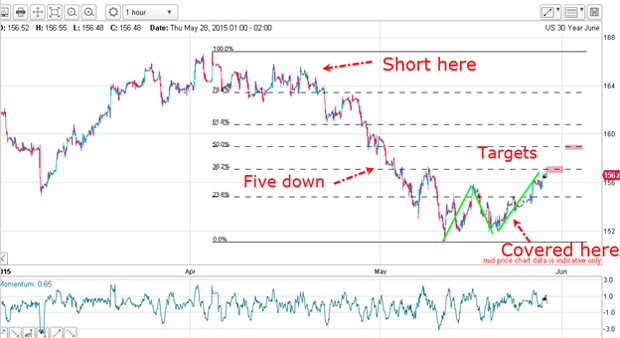
The market started to sell off in a five down and I took profits as the market appeared to be making a major turn.
I did nothing until the June contract had rolled over into the September, waiting for a new sell signal and I did not have to wait very long.
Here is the September bond:
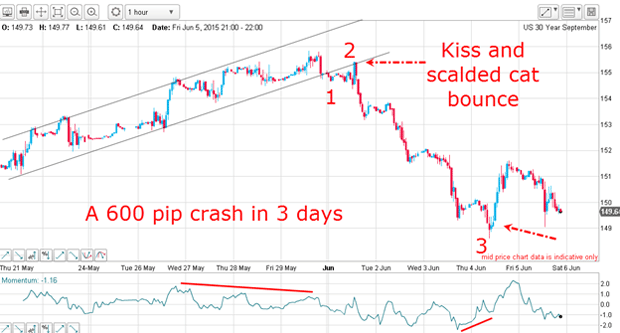
My tramline pair was superb, with a large momentum divergence into the late May high. When the lower tramline was broken, I had a clear signal that the trend was about to turn down.
The test came on the first day of June when the market rallied back to plant a traditional kiss on the lower tramline and then headed sharply down in a scalded-cat bounce. That was sure confirmation that the downtrend that started in April (see first chart above) had turned. I suspected we were in a third of a third wave the most powerful in the book.
Three days later, the market was down 600 pips a massive long liquidation and drove long-term rates up significantly. In fact, since the yield low in February, T-Bond yields have zoomed up by 30%.
But that positive-momentum divergence last Thursday was reason enough for me to take profits of $6,000 per £1 bet off the table.
Remember, all I did was note the initial bounce in May, wait for a new sell signal with the tramline kiss, and then go into the market and short it.
With that signal to cover in the form of a momentum divergence, I just had to grab that three-day profit. Thank you very much, hedge funds! As you know, I just love taking money off them.
So has the momentum divergence resulted in a decent bounce as I suspected last week?
I've taken big profits anything more is a bonus
I have a lovely tramline pair on the hourly chart as of this morning. The lower line has a good prior pivot point (PPP) and the two recent lows are accurate touch points (a key requirement). There is the spike kiss (wave 2) as an overshoot of the upper tramline, but the recent highs lying on it prove this line is solid resistance.
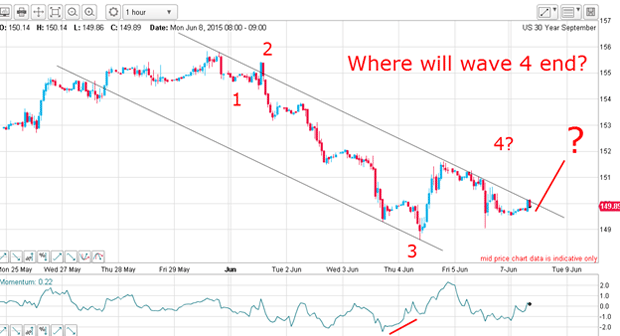
We are in wave 4, but it does not yet have the A-B-C format I would like to see. That lays open the possibility of a tramline break to perhaps the 152 153 area to complete wave 4 up.
But I am playing my split-bet strategy, and so I am not overly concerned about a possible move up. I am still short from the 155 area with part position (with stop at break-even), having taken partial profits of 600 pips last week.
If the upper tramline holds and wave 4 is finished, my remaining position will gain. But if we see an upside break, I will look to re-establish a short position.
You see, using the split-bet strategy allows me to be relatively relaxed about market moves a great emotional place for a swing trader to be in.
Get the latest financial news, insights and expert analysis from our award-winning MoneyWeek team, to help you understand what really matters when it comes to your finances.
John is is a British-born lapsed PhD physicist, who previously worked for Nasa on the Mars exploration team. He is a former commodity trading advisor with the US Commodities Futures Trading Commission, and worked in a boutique futures house in California in the 1980s.
He was a partner in one of the first futures newsletter advisory services, based in Washington DC, specialising in pork bellies and currencies. John is primarily a chart-reading trader, having cut his trading teeth in the days before PCs.
As well as his work in the financial world, he has launched, run and sold several 'real' businesses producing 'real' products.
-
 What are my retirement income options?
What are my retirement income options?We’re all told to save into a pension, but there’s widespread confusion about how to take an income from our savings and investments at retirement, a new study has found. We look at your retirement income options.
-
 UK interest rates: will the Bank of England lower rates?
UK interest rates: will the Bank of England lower rates?The Bank of England’s Monetary Policy Committee’s (MPC) final interest rates meeting of the year takes place tomorrow (18 December) and most experts expect a cut
-
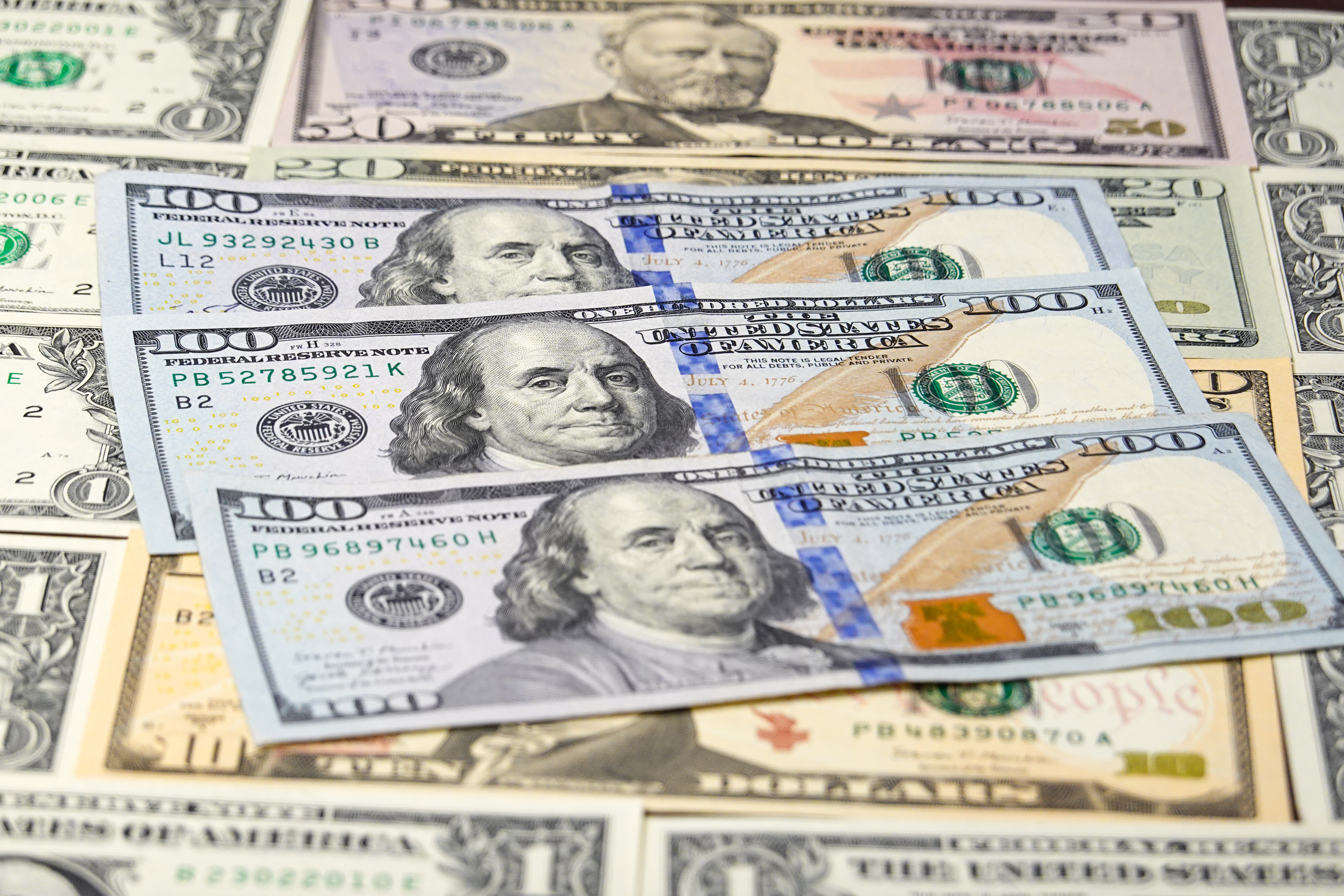 The challenge with currency hedging
The challenge with currency hedgingA weaker dollar will make currency hedges more appealing, but volatile rates may complicate the results
-
 It's time to back the yen, says Dominic Frisby
It's time to back the yen, says Dominic FrisbyThe Japanese yen has been weak for a long time, says Dominic Frisby. That may soon change.
-
 Investors dash into the US dollar
Investors dash into the US dollarNews The value of the US dollar has soared as investors pile in. The euro has hit parity, while the Japanese yen and the Swedish krona have fared even worse.
-
 Why a strong dollar hurts – and what you can do about it
Why a strong dollar hurts – and what you can do about itAnalysis The US dollar is at its strongest level in 20 years. That’s bad news for most investment assets, says John Stepek – here’s why
-
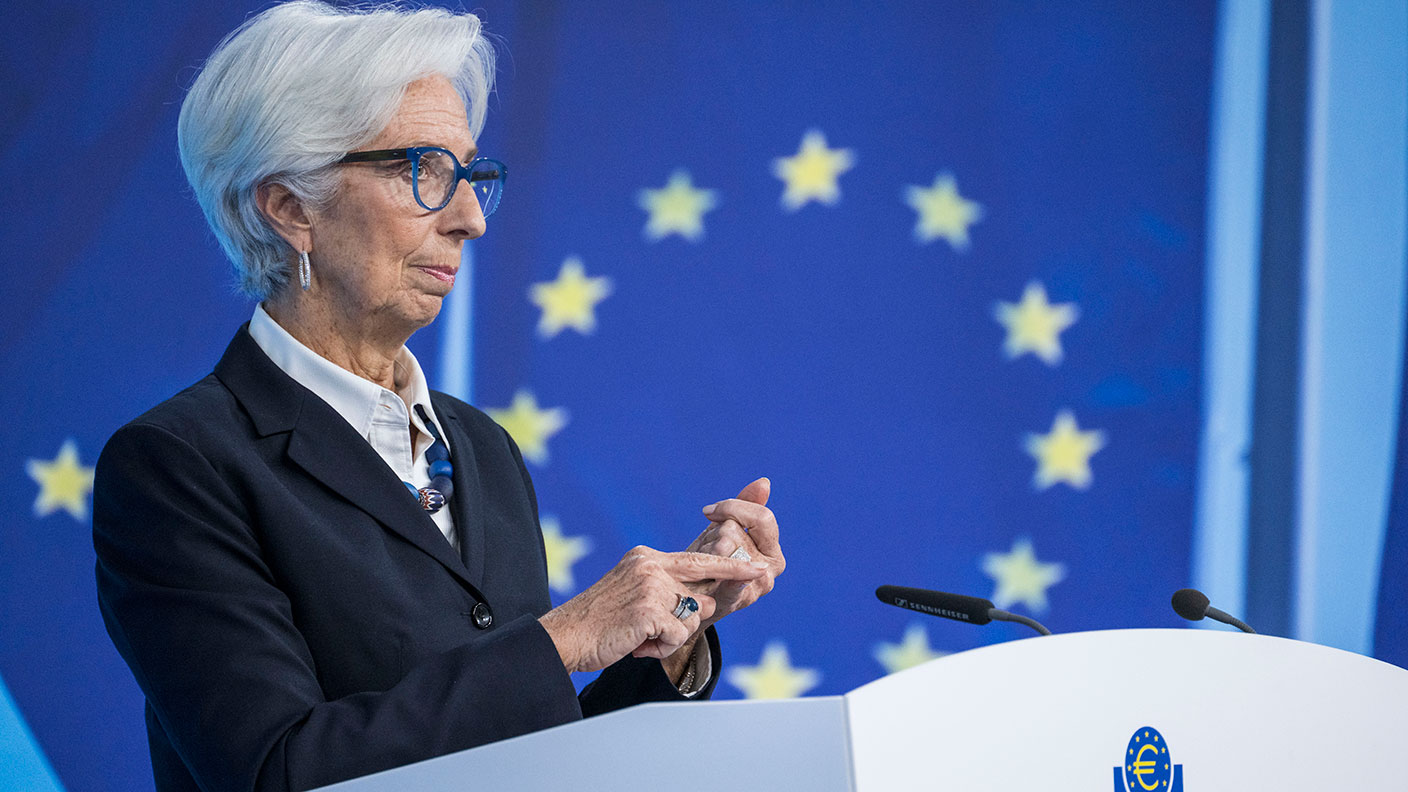 Could a stronger euro bring relief to global markets?
Could a stronger euro bring relief to global markets?Analysis The European Central Bank is set to end its negative interest rate policy. That should bring some relief to markets, says John Stepek. Here’s why.
-
 HubSpot: a tech stock set to tumble
HubSpot: a tech stock set to tumbleTips US tech stocks have had a fantastic couple of years. But this year is unlikely to be so bullish for high-fliers that can’t turn big profits.
-
 What does the future hold for central bank digital currencies?
What does the future hold for central bank digital currencies?Briefings Many of the world's central banks – including the Bank of England – have expressed an interest in creating their own digital currencies. Shivani Khandekar looks at the state of play in central bank digital currencies.
-
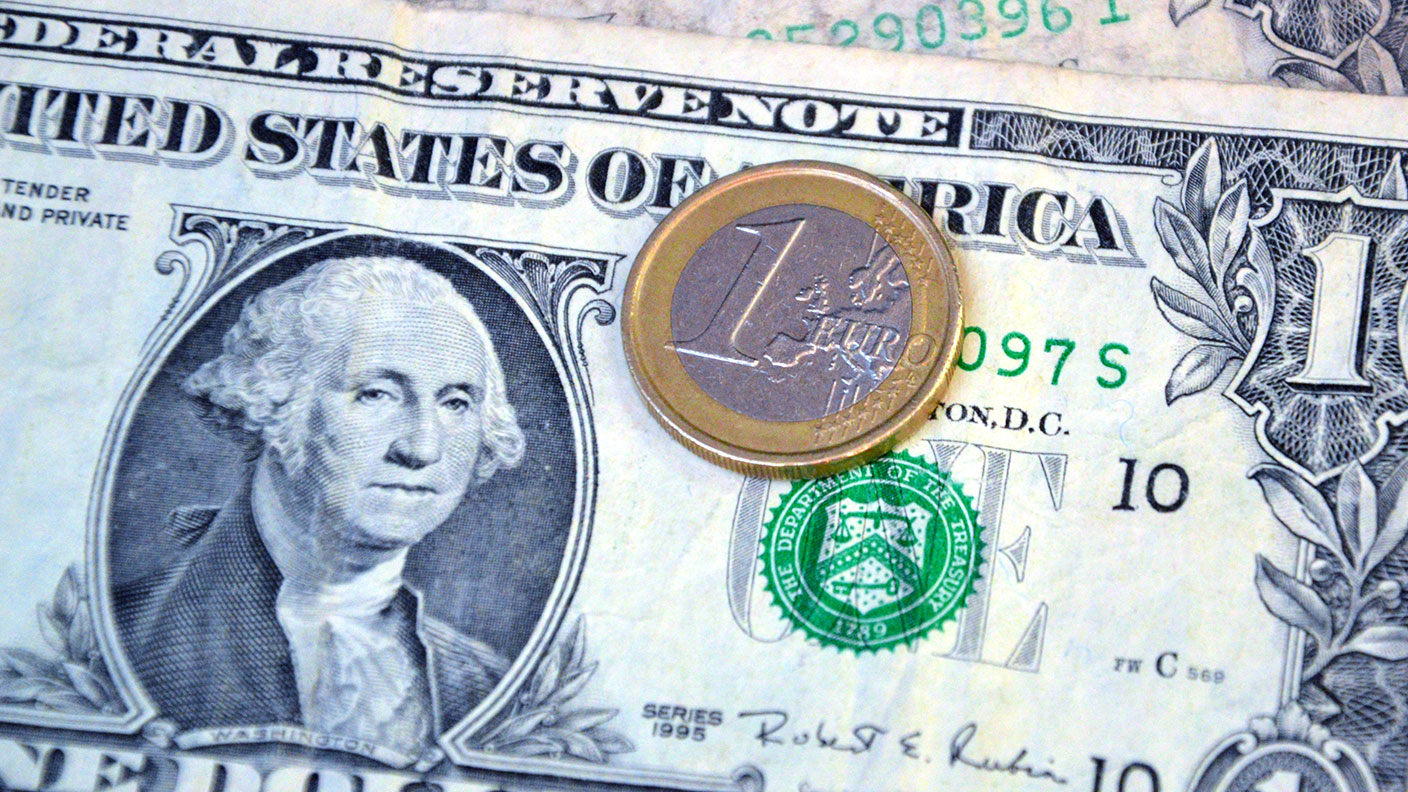 A weakening US dollar is good news for markets – but will it continue?
A weakening US dollar is good news for markets – but will it continue?Opinion The US dollar – the most important currency in the world – is on the slide. And that's good news for the stockmarket rally. John Stepek looks at what could derail things.